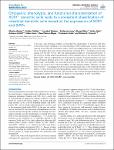Ontogenic, phenotypic, and functional characterization of XCR1+ dendritic cells leads to a consistent classification of intestinal dendritic cells based on the expression of XCR1 and SIRPα
Becker, Martina
Güttler, Steffen
Bachem, Annabell
Hartung, Evelyn
Mora, Ahmed
Jäkel, Anika
Hutloff, Andreas
Henn, Volker
Mages, Hans Werner
Gurka, Stephanie
Kroczek, Richard
In the past, lack of lineage markers confounded the classification of dendritic cells (DC) in the intestine and impeded a full understanding of their location and function. We have recently shown that the chemokine receptor XCR1 is a lineage marker for cross-presenting DC in the spleen. Now, we provide evidence that intestinal XCR1+ DC largely, but not fully, overlap with CD103+ CD11b− DC, the hypothesized correlate of “cross-presenting DC” in the intestine, and are selectively dependent in their development on the transcription factor Batf3. XCR1+ DC are located in the villi of the lamina propria of the small intestine, the T cell zones of Peyer’s patches, and in the T cell zones and sinuses of the draining mesenteric lymph node. Functionally, we could demonstrate for the first time that XCR1+/CD103+ CD11b− DC excel in the cross-presentation of orally applied antigen. Together, our data show that XCR1 is a lineage marker for cross-presenting DC also in the intestinal immune system. Further, extensive phenotypic analyses reveal that expression of the integrin SIRPα consistently demarcates the XCR1− DC population. We propose a simplified and consistent classification system for intestinal DC based on the expression of XCR1 and SIRPα.
Dateien zu dieser Publikation
Keine Lizenzangabe

